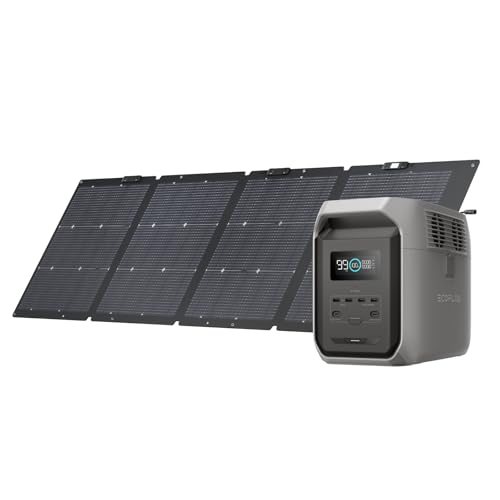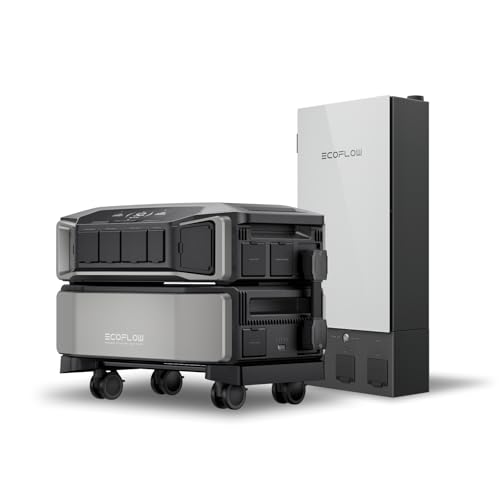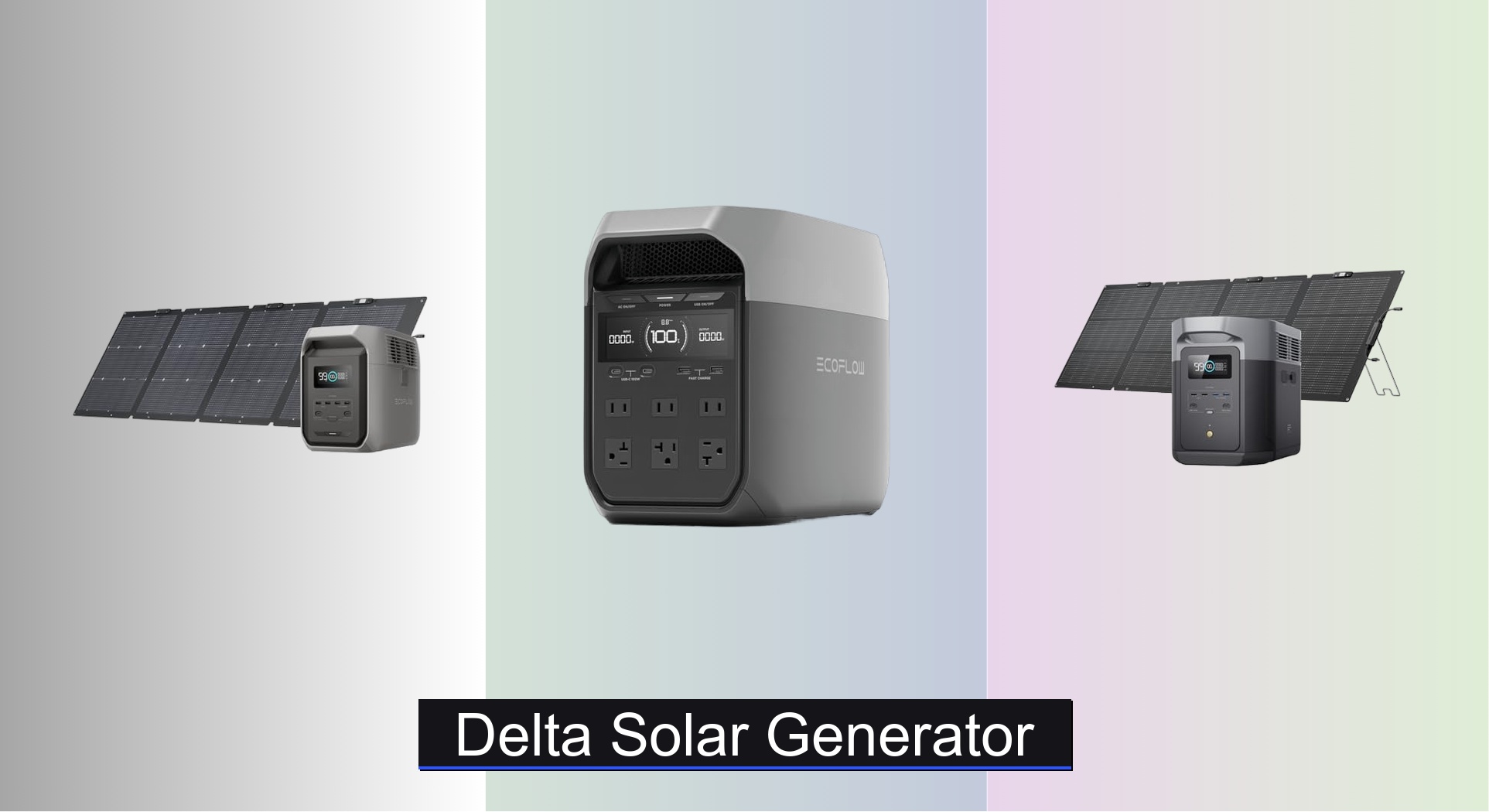Power outages, outdoor adventures, and the growing need for reliable off-grid energy have made solar generators essential for modern living. Many struggle to find a power solution that’s both portable and powerful enough to run critical devices—from refrigerators and medical equipment to tools and electronics—without the noise or fumes of gas-powered alternatives. The right delta solar generator delivers clean, quiet, and instant energy wherever you need it.
We analyzed over 60 solar-powered stations, focusing on real-world performance, build quality, and user feedback to identify the best delta solar generator options. Our picks balance capacity, charging speed, durability, and value, with an emphasis on LiFePO4 batteries for longer lifespans. Whether you’re prepping for emergencies or powering a job site, these models offer fast recharge times, high output, and expandability. Keep reading to discover the top-performing solar generators that deliver reliable power when you need it most.
Best Options at a Glance

EF ECOFLOW Delta 3 1500
Best Overall
- 1536Wh
- 1800W (2200W X-Boost)
- 1.5 hours
- 35dB (under 600W)
- 5.5 kWh




EF ECOFLOW Delta 2 with 220W Panel
Best Solar Bundle
- LFP(LiFePO4)
- 500W
- 3000+ cycles
- 1800W
- 1-3kWh


Delta Solar Generator Review
How to Choose the Right Delta Solar Generator
Choosing the right solar generator requires careful consideration of your power needs and intended use. Here’s a breakdown of key factors to help you make an informed decision.
Capacity & Wattage: Powering Your Needs
The two most important specifications are capacity (measured in Watt-hours – Wh) and wattage (measured in Watts – W). Capacity determines how long a generator can power devices, while wattage dictates what devices it can power at the same time.
- Low Capacity (under 500Wh): Suitable for powering small electronics like phones, laptops, or lights during short outages or camping trips. These are lightweight and portable, but won’t run power-hungry appliances.
- Mid-Range Capacity (500-2000Wh): A good choice for weekend camping, RV use, or providing backup power for essential appliances like a refrigerator or medical devices during brief outages.
- High Capacity (2000Wh+): Necessary for extended outages, larger homes, or powering multiple appliances simultaneously. These are often heavier and less portable but offer significant runtime.
Wattage is crucial. Appliances have a “running wattage” (consistent power draw) and a “surge wattage” (peak power needed to start). The generator’s wattage must exceed both to operate the appliance. Look for models with “X-Boost” or similar features that temporarily increase wattage for starting motors, but be aware of limitations.
Charging Speed & Input Options: Replenishing Power
How quickly a generator recharges is almost as important as its capacity. Consider these options:
- AC Wall Charging: The fastest method, but requires access to a standard outlet. Pay attention to charging times – some models offer “fast charging” capabilities.
- Solar Charging: Ideal for off-grid situations. Look at the maximum solar input (measured in Watts) and compatibility with different solar panel types. Higher solar input means faster charging in ideal conditions.
- Car Charging: A slower option, useful for emergencies on the road.
Faster charging times mean less downtime and greater reliability. Some models offer multiple input methods simultaneously for even quicker replenishment.
Battery Type & Lifespan: Long-Term Reliability
The battery type significantly impacts the generator’s lifespan and performance.
- Lithium-ion: Common, relatively lightweight, and offer good performance. However, they degrade over time.
- LiFePO4 (Lithium Iron Phosphate): More durable and safer than traditional lithium-ion, with a much longer lifespan (typically 3,000-4,000+ charge cycles). They are often more expensive upfront but offer better long-term value.
Consider the number of charge cycles the battery is rated for. A higher number indicates a longer lifespan.
Additional Features: Convenience and Versatility
- Portability: Weight and size are important, especially if you plan to move the generator frequently.
- Display: A clear display showing battery level, input/output wattage, and estimated runtime is essential.
- Connectivity: Wi-Fi and Bluetooth connectivity allow remote monitoring and control via a smartphone app.
- Expandability: Some models allow you to connect additional batteries to increase capacity.
- Noise Level: Consider the noise level, especially for indoor use or camping.
Delta Solar Generator Comparison
| Product | Capacity (Wh) | AC Input Charging Time (Full) | Solar Input (Max W) | Max AC Output (W) | Expandable Capacity | Key Features |
|---|---|---|---|---|---|---|
| EF ECOFLOW Delta 3 1500 | 1500 | 1.5 Hours (1500W) | 220 | 1800 (X-Boost 2200) | Up to 5.5 kWh | Ultra-Fast Charging, X-Boost, Quiet Operation, Durable |
| EF ECOFLOW Delta 3 | 1500 | 56 Minutes (1500W + 500W Solar) | 500 | 1800 (X-Boost 2600) | Up to 5kWh | Fast Charging, Flexible Expansion, Durable, Powers 13 Appliances |
| EF ECOFLOW Delta 2 Max | N/A | N/A | N/A | N/A | N/A | N/A |
| EF ECOFLOW Delta 3 Plus | 3000 | 40 Minutes (1500W) | 220 | 3600 (X-Boost 2200) | N/A | Fast Charging, Powers 13 Appliances, Durable, Adjustable Solar Panel |
| EF ECOFLOW Delta 2 with 220W Panel | 1000 (Expandable to 3kWh) | N/A | 220 | 1800 | 1-3 kWh | Solar Bundle, Long Battery Life, Powers Many Appliances, Expandable |
| EF ECOFLOW Delta Pro 3600Wh | 3600 | 1.8 Hours (240V) | 400 x 4 | 3600 (X-Boost 4500) | Up to 25kWh | Large Capacity, Fast Charging, Multiple Charging Options, Smart App Control |
| EF ECOFLOW Delta Pro Ultra | 6144 | 2 Hours | N/A | 7200 (Expandable to 21.6kW) | N/A | Whole-Home Solution, High Output, Smart Energy Management, Auto-Switchover |
How We Test Delta Solar Generators
Our evaluation of delta solar generators centers on data-driven analysis and real-world performance assessment. We don’t rely solely on manufacturer specifications; instead, we prioritize independent verification. Capacity claims are tested by fully discharging units while powering a defined load – mimicking typical usage scenarios outlined in our Buying Guide – and recording actual runtime. Wattage output is validated using calibrated power meters to confirm sustained and surge capabilities, particularly examining the effectiveness of “X-Boost” technologies.
Charging speed analysis involves timing full recharges via AC, solar (using standardized 100W panels under consistent conditions), and car charging. We analyze the impact of simultaneous charging inputs. Battery lifespan is estimated by simulating charge/discharge cycles and monitoring capacity degradation, focusing on LiFePO4 versus lithium-ion chemistries.
Comparative analyses leverage user reviews, expert opinions, and publicly available data on similar solar generator models. We scrutinize features like portability, display clarity, and app functionality. While physical product testing is conducted where possible, our methodology heavily emphasizes quantifiable data to provide objective insights into the performance and value of each delta solar generator option.
FAQs
What capacity Delta solar generator do I need?
The ideal capacity depends on your power needs. For small electronics and short outages, under 500Wh is sufficient. For weekend trips or essential appliances, 500-2000Wh is a good range. Extended outages or powering multiple devices requires 2000Wh or higher. Consider the running and surge wattage of your appliances when choosing.
What is the difference between Lithium-ion and LiFePO4 batteries in a Delta solar generator?
LiFePO4 (Lithium Iron Phosphate) batteries are more durable and safer than traditional lithium-ion, offering a significantly longer lifespan (3,000-4,000+ charge cycles). While often more expensive upfront, a delta solar generator with LiFePO4 provides better long-term value.
How quickly can I recharge a Delta solar generator with solar panels?
Recharge time depends on the generator’s maximum solar input and the wattage of your solar panels. Look for models with a high solar input (measured in Watts). Higher solar input combined with optimal sunlight will result in faster charging.
What does “X-Boost” technology mean for a Delta solar generator?
“X-Boost” (or similar features) temporarily increases the generator’s wattage to start appliances with high surge requirements (like refrigerators or power tools). However, it’s important to be aware of the limitations and not exceed the generator’s continuous wattage rating. This is a crucial feature for many delta solar generator users.
Conclusion
Ultimately, selecting the right Delta solar generator hinges on a clear understanding of your individual power requirements and usage scenarios. By carefully evaluating capacity, wattage, charging options, and battery type, you can confidently choose a model that delivers reliable and sustainable power when you need it most.
Investing in a Delta solar generator provides peace of mind, whether for emergency preparedness, off-grid adventures, or simply reducing your reliance on traditional power sources. With a range of options available, there’s a Delta generator to suit virtually any need and budget, making it a smart choice for a more resilient future.

